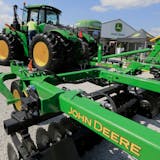As it marks its fifth anniversary, the Northstar commuter rail line finds itself plagued by a steep decline in on-time performance and a related slump in ridership.
Average on-time performance on the line, which links the Twin Cities' northern suburbs to Target Field Station in downtown Minneapolis, plummeted from a high of 97 percent in 2012 to 66 percent in 2014, Metro Transit numbers show. Average weekday ridership has also tumbled 8 percent, from 2,783 last year to 2,550 this year.
The line's recent struggles, which have persisted despite a $1 rate reduction in 2012-13 and a coupon campaign offering free rides, stand in contrast to the success of the Twin Cities' Green and Blue light-rail lines.
But officials at Metro Transit, which operates both the commuter and light-rail lines, point out that the Northstar line shares its rails with freight trains, while the light-rail lines run on their own tracks. Congestion and delays on the Northstar line are largely due to increased freight and oil train traffic, they say.
Brian Lamb, Metro Transit's general manager, said Northstar will restore its on-time reliability, which should swell ridership.
He said BNSF, which owns the tracks, has made upgrades and scheduling changes that will help Northstar. In addition, he said, the line is emphasizing customer service, including station improvements and the recent addition of Wi-Fi to all trains.
"We think this investment should not be looked at on a year-to-year basis. This is a longer-term infrastructure investment," Lamb said. "We continue to try and make the service safer and more convenient."
Northstar cost $320 million in federal, state and local funds to build. The Minnesota Twins also contributed $2.6 million.



